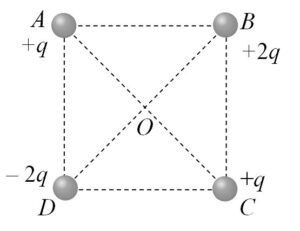Electrostatics-10 Important basic MCQs (Quiz) Part 1
1.An isolated solid metallic sphere is given charge +Q. The charge will be distributed on the sphere
(A) Uniformly but only on surface
(B) Only on surface but non-uniformly
(C) Uniformly inside the volume
(D) Non-uniformly inside the volume
2. Four charges are arranged at the corners of a square ABCD, as shown in the adjoining figure. The force on the charge kept at the centre O is

(A) Zero
(B) Along the diagonal AC
(C) Along the diagonal BD
(D) Perpendicular to side AB
3.The ratio of the forces between two small spheres with constant charge in (a) air (b) in a medium of dielectric constant K is
(A) 1 : K
(B) K : 1
(C) 1: K^2
(D) K^2 : 1
4. Three charges 4q , Q and q are in a straight line in the position of 0, l/2, and l respectively. The resultant force on q will be zero, if Q=
(A) – q
(B) – 2q
(C) -\frac q2
(D) 4q
5.Two charges each of 1 coulomb are at a distance 1 km apart, the force between them is
(A) 9\;\times\;10^3\;Newton\;
(B) 9\;\times\;10^{-3}\;Newton\;
(C) 1.1\;\times\;10^{-4}\;Newton\;
(D) 10^4\;Newton\;
6. There are two metallic spheres of same radii but one is solid and the other is hollow, then
(A) Solid sphere can be given more charge
(B) Hollow sphere can be given more charge
(C) They can be charged equally (maximum)
(D) None of the above
7. Three equal charges are placed on the three corners of a square. If the force between q_1 and q_2 is F_{12} and that between q_1 and q_3 is F_{13} , the ratio of magnitudes \frac{F_{12}}{F_{13}} is
(A) \frac12
(B) 2
(C) \frac1{\sqrt2}\;
(D) \sqrt{2\;}
8. Two small spheres each having the charge Q are suspended by insulating threads of length from a hook. This arrangement is taken in space where there is no gravitational effect, then the angle between the two suspensions and the tension in each will be
(A) 180^o,\;\frac1{4\mathrm\pi\;\in_{\mathrm o}}\frac{Q^2}{{(2L)}^2}
(B) 90^o,\;\frac1{4\mathrm\pi\;\in_{\mathrm o}}\frac{Q^2}{{L}^2}
(C) 180^o,\;\frac1{4\mathrm\pi\;\in_{\mathrm o}}\frac{Q^2}{2 L^2}
(D) 180^o,\;\frac1{4\mathrm\pi\;\in_{\mathrm o}}\frac{Q^2}{ L^2}
9. A soap bubble is given a negative charge, then its radius
(A) Decreases
(B) Increases
(C) Remains unchanged
(D) Nothing can be predicted as information is insufficient
10. With the rise in temperature, the dielectric constant of a liquid
(A) Remains unchanged
(B) Changes erratically
(C) Increases
(D) Decreases

Pingback: Electrostatics-10 Important basic MCQs (Quiz) Part 3